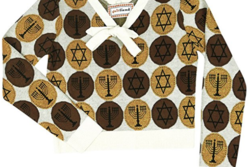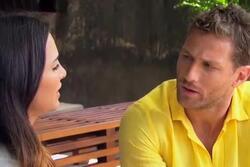A Better Hanukkah Movie, With Plenty of Room for Improvement
“Merry Christmas!” the Hallmark Channel exclaims in a commercial between movies, before viewers hear the opening notes of a Klezmer song. Time to curl up in your cozy pajamas with a mug of hot chocolate and a Hallmark movie about…Hanukkah.
The Hallmark Channel might be known for its Christmas movies, but for the past few years, it’s been cranking out Hanukkah movies, too. There's an interesting tension at play in these movies: Hallmark offerings are heart-warmingly predictable, protective of the status quo, whereas Hanukkah is a complex and dynamic tradition that evolved from a minor festival to a major December holiday to include American Jewry in the season of coziness, family, and light.
After several, incrementally better attempts, the Hallmark Channel finally carves out a respectable place for Hanukkah with Hanukkah on Rye (which came out December 18). But is this the best we can hope for?
Until recently, Hallmark depictions of Hanukkah were basically Christmas movies that included a few Jewish characters. In Double Holiday, a Jewish “career woman” tasked with planning an office Christmas party learns about her colleagues' traditions, and vice versa. In Holiday Date, a woman recently dumped by her boyfriend hires a date to bring home for the holidays. He turns out to be Jewish and introduces the family to Hanukkah. Although both movies touch on Hanukkah, they focus on Christmas and center Christianity.
In the Hallmark Universe, the year 2020 marked a shift to a different kind of Hanukkah movie—one that was actually about Hanukkah. In the opening scene of Love, Lights, Hanukkah, we see Christina, newly single and grieving her recently deceased mother, decked out in Santa snowmen earrings while decorating for Christmas—all Hallmark tropes. But she learns through a DNA test that she’s half-Jewish. At the emotional climax of the movie, we hear the traditional Hanukkah song “Maoz Tzur,'' as we watch the cast light a large menorah. The movie at least provides an accurate and somewhat more substantial depiction of Hanukkah than its predecessors. Still, because of the interfaith narrative, American Christianity remains at the center.
The following year, Eight Gifts of Hanukkah featured a female Jewish doctor who, on each night of Hanukkah, receives interest from a different secret admirer—all conventionally attractive Jewish men. Finally, a Hanukkah movie without a Christian main character!
But this year’s movie, Hanukkah on Rye, is the most Jewish to date. It features competing Jewish delis and two meddling bubbies who each hire a matchmaking service to set up their grandchildren, Jacob and Molly. Both leads are played by Jewish actors: Jeremy Jordan, and the Israeli actress Yael Grobglas.
Having Jewish actors play these roles makes a difference. As a viewer, when I know that the actor is Jewish, that heightens my ability to identify with them. As a Jewish woman, I can relate to Molly/Yael Grobglas, and I can imagine Jacob/Jeremy Jordan as any boy that I crushed on at Jewish summer camp. Jacob and Molly’s romance might be as cheesy and predictable as in any other Hallmark movie, and that’s the point: Jews can be as cheesy and predictable as any other Hallmark character. In a way, that’s progress. Hanukkah on Rye creates a Jewish sense of belonging within the Hallmark Universe. No one needs to be “introduced” to Judaism or to Christmas; both protagonists’ identities are established as Jewish, and no one is trying to convert them.
As the movie’s name suggests, Jewish deli food plays a prominent role. As Jacob and Molly get to know each other, they discuss how this Jewish tradition should engage with contemporary American life. While Molly’s family deli, Gilmore’s, focuses on history, tradition, and resisting change, Jacob’s family deli, Zimmer’s, is more flexible and open to incorporating other cultural influences. For example, the deli serves Chinese food on Christmas. a longtime Jewish-American tradition.
Hanukkah on Rye is explicit about its characters’ Jewish identities. Throughout the film, Molly wears blue sweaters and a Star of David necklace, in addition to her grandmother’s hamsa. Behind her home desk, viewers can see a large, blue and silver Jewish star, a kiddush cup, and other Judaica.
The color scheme is no accident. In fact, it was the Hallmark card company that, throughout the twentieth century, built an association between Hanukkah and blues, silvers, and whites— traditional colors of the tallit and the Israeli flag—to signal potential customers toward Hanukkah cards amid the reds and greens of Christmas. In doing so, Hallmark invited Jewish Americans into December consumerism.
A movie like Hanukkah on Rye helps to carve out a slightly larger space for Hanukkah within the ever-expanding Christmas (or “holiday”) season, a time when Jewish Americans can feel their minority status most acutely. Ironically, Hanukkah is actually a relatively minor Jewish holiday; unlike the High Holidays or Shabbat, Jewish law doesn’t prohibit working on Hanukkah. But over time, Hanukkah grew in the US to catch up to Christmas, and Jewish Americans intentionally facilitated much of that growth.
Although it may be an improvement in terms of depictions of Jews and their traditions, Hanukkah on Rye suffers from some familiar problems. Notably absent from the film is any mention of the rise in antisemitism amid a polarized nation. The Hallmark Universe is masterful at avoiding difficult realities and topics.
The movie also fails to reflect the rich diversity of Jewish experience. In Hanukkah on Rye, all Jewish people are Ashkenazi and white. And more generally, white people are still front and center, while people of color are peripheral and underdeveloped. For example, Thomas is a Black man and desk clerk at the apartment building where Jacob and Molly both live. Jacob talks to Thomas, but Thomas never gets a chance to contribute to their conversation in a meaningful way, so we never learn much about him. Instead, we mostly see Thomas sip from a mug while Jacob and Molly converse in front of him.
An ideal Jewish Hanukkah movie would include Jewish and (non-Jewish ) people of color, as fully developed characters with the intersections of their identities integrated into the plot. It might also incorporate more interesting and diverse interfaith narratives. Hanukkah On Rye is certainly an improvement over earlier Hanukkah movies, but the Hallmark franchise still has a lot of work to do.







Aa a Gentile, I appreciated that the movie was produced at all and offered an opportunity for me to learn more.